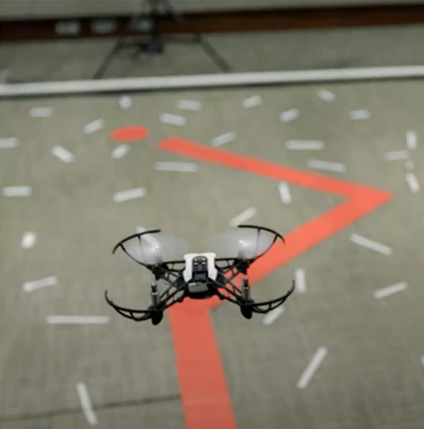Formula for Success: In conversation with MathWorks Minidrone Competition – Europe, Middle East & Africa 2022 Winners
Joining us today is Manjunath Rajmohan who joined the student programs team to support the Minidrone Competition and student challenges. In today’s post, Manjunath chats with the winners of MathWorks Minidrone Competition – EMEA 2022. Over to you, Manjunath…
MathWorks Minidrone Competition has been crafted to enable students to learn key concepts through a fun filled approach and be industry ready. The challenge provides an opportunity for students to design a Minidrone line follower and learn Model-Based-Design hands-on using Simulink.
Model-Based Design enables fast and cost-effective development of dynamic systems, including control systems, signal processing systems, and communications systems. For many aspiring engineers, a key avenue toward learning Model-Based-Design has been through their participation in the MathWorks Minidrone Competition.
Today we’re talking to Team Tabono, from University of Uyo, Nigeria, the winners of “The MathWorks Minidrone competition – EMEA 2022”. We will be interacting with Kingsley Udofia, Emmanuel Ogungbemi, Chidinma Kalu, and Oluwaseun Ilori, the members of Team Tabono.

The Drive to Participate
Hosting the competition in the post pandemic environment has required major adjusting – especially to the format of the competition. With the safety of students being our top priority, MathWorks ensured the competition format was virtual. The format ensured that the competition opened to a larger audience across countries in Europe, Middle East, and Africa (EMEA) region. However, it put the adaptability aspect of students to test.
The students rose to the challenge and the MathWorks Minidrone Competition – EMEA 2022 witnessed a staggering 300+ team registrations from 44 different countries. The top 9 teams were shortlisted for the finals post the simulation round.
When asked about the driving factor to participate in the competition, OluwaseunIlori, a member of team Tabono, says
“One of our staff members informed us about the contest after receiving a notification about it through her MathWorks account. After some discussion, we decided to throw our hats into the ring. We have been using MATLAB to complete numerical simulation school assignments, so we thought that taking part in this project would be an opportunity to challenge ourselves and learn something new in a competitive environment”
Getting Started
To enable students to quickly get started, MathWorks provides numerous resources in line with the competition. We spoke to the team to understand how these resources helped them in their journey.

“It was quite helpful to have the early materials made available to us, such as the ‘getting started guide’ and videos on the MathWorks Minidrone Competitions webpage. It gave us a good starting point in understanding the workflow, the image processing system, and the flight control system using Simulink and the Stateflow Chart” says Kingsly Udofia, Captain, Team Tabono.
“The MATLAB and Simulink Onramp introductory tutorials and videos which could be accessed directly within MATLAB were also of great help”, he added.
The Experience
In our interaction with the team, we were intrigued to hear about the learning curve and understand how students found the competition useful.
In students’ words: Has the competition helped learn new technologies?

“Drones are ubiquitous today, however, this was our first time developing an algorithm for one and simulating it. We also got introduced to working hands-on with Simulink and learning by doing always has a lasting impression on the exploration journey. We gained useful experience, especially on working as a team, because of this competition” says Chidinma Kalu, Member, Team Tabono.
“Starting with something new can be challenging, and that was certainly the case when we first encountered Model-Based Design. However, we persevered and worked through the learning process. We went through multiple iterations to prototype our solution, trying them in simulations to eventually come to a result satisfactory to us” he added.
The Winning Formula
To help all the participants of future competitions, we asked the team to share some useful tips on how students can better approach the competition.
Team Tabono shares a success formula to ace the competition.
“Participants should use the tools /reference model that MathWorks has made available to them, including the videos, tutorials, and documentation, or else they risk having a challenging beginning. They ought to use a fresh algorithm to address the problem at hand. This will ensure a strong possibility of getting through the simulation round, and eventually succeeding. It gets easier with every step forward.”
What’s Next
The competition has helped the team learn, use, and witness how Simulink helps in rapid virtual prototyping of control systems.
On being asked how Simulink could help the team in the future, Emmanuel Ogungbemi, member of Team Tabono, says “Simulink being a very versatile tool for simulation helps bring down the overall product development time. Its capability to simulate complex systems is valuable for testing conditions that might be difficult to reproduce with hardware prototypes alone. One of our team members is currently working on Software Defined Radios using Simulink”
Key Takeaways
The team stated that “The experience opened our eyes as much as it confirmed our convictions that problems are chances to find answers and that working together as a team is essential for project success. It has made us more aware of the virtually endless possibilities that come with using MathWorks products”
Hope this conversation was useful to all our readers. If you are interested in participating, sign up for an upcoming Minidrone Competitions near you
If you would like to host the MathWorks Minidrone Competition on your campus, club, or class, drop us an e-mail at minidronecompetition@mathworks.com.








Comments
To leave a comment, please click here to sign in to your MathWorks Account or create a new one.